
SOUVENIRS of Dromana including old and new photos, history books, and seeds of local plants and trees have been buried in a time capsule on the foreshore to be opened in 50 years.
Dromana foreshore management committee buried the time capsule beside the Bay Trail on the foreshore opposite St Mark’s Anglican Church on a windswept Saturday 30 April in front of about 30 people.
Guests included Flinders MP and Environment Minister Greg Hunt (with his young son James in soccer gear) and shire mayor Cr Graham Pittock.
The 100-litre, high-density plastic capsule was buried 40 centimetres deep and is covered with a concrete slab topped by a 500 kilogram granite rock from Arthurs Seat, with a plaque on top.
Foreshore committee vice-chairman Rob Tannahill said the plaque contained details of when it is to be opened in 50 years. He said the capsule included historic photos from Dromana Historical Society, recent photos taken from similar locations, material from Dromana Red Hill RSL (the original RSL hall built in 1919 still stands nearby, now used by scouts), books about Dromana, current newspapers, and a “collection of odds and ends”.
The foreshore’s head ranger Michael Everitt collected seeds for the capsule. Sealed in an airtight container with silica gel are seeds of “assorted indigenous grasses, herbaceous perennials, casuarinas, banksias, coastal eucalypts, and melaleucas” (including tea trees), he said. It was hoped they would be planted after the capsule was opened in 2066.
Mr Tannahill told those at the capsule sealing ceremony the large rock would ensure the time capsule did not blow away.
Mr Hunt praised the committee’s work. “It’s almost exactly four years since I attended the unveiling of a plaque in May 2012 to mark where explorer Matthew Flinders came ashore at Dromana in 1802,” he said.
Flinders, credited with naming Australia (previously known as New Holland), and regarded as one of the great navigators of his time, sailed into the unchartered waters of Port Phillip on 26 April as part of his circumnavigation of Australia between December 1801 and June 1803, which had been commissioned by Joseph Banks.
The crowd laughed when Cr Pittock said the rock would ensure the time capsule did not blow away, but the peninsula was relying on Mr Hunt to ensure it did not wash away through higher sea levels. Mr Hunt grimaced, but did not reply.
The foreshore committee is installing the second of several exercise stations on its patch and is about to start building a viewing platform for people in wheelchairs, which will be opposite the information centre.
First published in the Southern Peninsula News – 10 May 2016